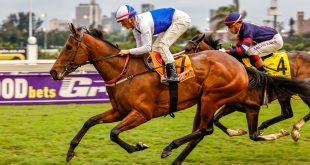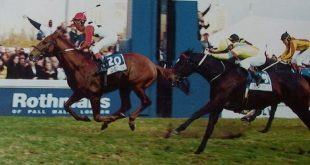The answer to the oft posed question; ‘is it possible to make a living from betting on horseracing?’ would probably be ‘yes’ – provided the occupation is treated like any normal business and with equal dedication.
However, a secondary question would be whether the returns justify the time spent? The returns would likely range from extremes of handsome winning months to demoralising losing ones. Most mortals would not be able handle that sort of pressure. Therefore, the majority of serious punters view the game rather as a means towards supplementing their incomes. However, even this group seldom make a profit from punting and they would likely not need this article to remind them.
Horseracing is a viable betting medium due to the consistency of the thoroughbred. A horse losing by a length over a mile has performed 99,8% as well as the winner. The job of the handicapper is to ensure that they finish even closer next time. This makes it tougher for the punter, but also allows those who do their homework to have “an edge”. Handicappers can slip up and in South Africa they are also bound by certain conditions. This edge is what separates horseracing betting from games of chance.
“Value” is the cornerstone principle of the most successful professional punters. It is possible to work out that a horse which is paying R10 a win should actually be paying R5, because detailed form analysis reveals that it is better handicapped than its more fancied rivals. The punter who only ever backs these types will make a profit according to the theory of the law of averages. Those who believe the secret is simply to pick the winner no matter the price will likely bet on more races and their strike rates will have to be higher than the value seekers’.
Tote exotics like Jackpots and Place Accumulators are very popular and here once again value plays an important role. Punters looking for a banker who calculate that a third favourite should actually be the favourite will immediately be in the pound seats if this horse converts their confidence. Successful punters would seriously consider making such a horse a banker and if they don’t they would likely only include even bigger priced horses in the betting, having already formed the opinion that their choice will beat the two most fancied horses. Conversely, lesser punters will likely include the first and second favourites for safety’s sake. Therefore their profits will be cut considerably and once again they would likely have to win the exotics more often than the value seekers in order to match the latter’s returns.
The first few races on the card are not part of the Jackpot and Pick 6 exotics, and fittingly are also the best races on which to place win and place bets. This is simply due to the fact that in plate races like Maidens the best horses will come out on top, which is not always the case in handicaps. However, Maidens require serious study and in this regard previous race replays are a valuable tool. In South Africa race replays can be watched on www.racingassociation.co.za while KZN races can be watched on Youtube by searching for “Gold Circle Racing”. Those inexperienced horses which will likely improve in their next starts can be picked out in these replays. Furthermore, collateral form analysis in formguides like Computaform or www.gallop.co.za can enable punters to ascertain the strength of relevant Maiden races. Therefore, excellent value can often be found in these races. Recently, a horse called Antagonist finished third at odds of 75/1 when suddenly dropped down to 1000m from a string of races run over distances between 1600m and 2600m. He was sent out at odds of 45/1 in his next start, also over 1000m, on the grounds that his third place finish had occurred in a weak workrider’s event. However, the replay of the latter race told a different story. Firstly, he had jumped from an unfavourable high draw on the Vaal Inside track and at the business end had been carried even further outward by a compounding horse. He then charged home to finish 1,5 lengths back. He was now jumping from a favourable high draw at Turffonten and collateral form study revealed that this field was not much stronger. The place was paying R8,50, excellent value, and he duly ran on well for a 0,5 length second.
On the other end of the spectrum a horse called Balado started favourite for a maiden at The Vaal over 1400m about a year ago on the grounds he was trained by Sean Tarry, ridden by top workrider Lyle Hewitson, owned by Chris van Niekerk and had improved in just his third start last time out to finish a close second over this trip. However, he was already a six-year-old and the replay of that last start revealed he had had the run of the race and was a decidedly one-paced sort. Collateral form evidence suggested the previous race had been just as weak as this one. He duly finished unplaced and well beaten.
The lesson learnt from the above two examples is that a properly studied race will include analysis to some degree of every horse in the race and not just of the first few in the betting, while betting on a whim must be avoided at all costs.
In this regard the respected UK-based professional punter Alan Potts advises, “Make a plan – what races will you bet on, how many bets, what stakes and so on. The basics since I stopped being a loser have been to watch a lot, listen a little, ignore ‘inside information’, be cynical about hype and rely on my own judgement.”
Most punters probably do arrive at the course with the best laid out plans, but the majority will soon abandon them and end up off the rails.
One of the biggest recognised pitfalls is the “Pot of Gold” mentality” and tied in with this is “FOMO”, which stands for “Fear Of Missing Out.” Having taken a trifecta a punter’s mind will suddenly picture a “roughie” finishing fourth, or two of the outsiders in the aforementioned trifecta finishing one-two. Quartets and exactas are then taken and maybe swingers, all-to-comes and Pick 3s too … just in case. This sort of error will likely put undue pressure on the budget.
However, the probable biggest pitfall of all is to “chase.” A punter makes a handsome profit on Friday and later spends it with abandon. He or she arrives on Saturday with the remaining money but quickly loses it. Suddenly that spending spree is looking expensive, so he/she draws more money. However, his/her tried and tested theories now tend to go out of the window. Rather, the aim becomes to look for bets that will bring the balance back to square. Logic takes a back seat and it becomes an exercise in throwing away hard earned cash.
– David Thiselton






